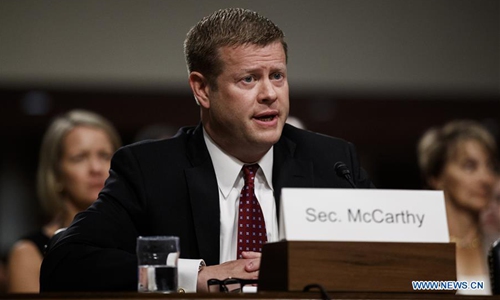HOME >> OPINION
Be wary of US move to stir up trouble in South China Sea
By Shi Tian Source:Global Times Published: 2020/1/14 21:38:41

US Army Secretary Ryan McCarthy. File photo: Xinhua
The beginning of 2020 has seen turbulence in the South China Sea.
US Army Secretary Ryan McCarthy said on Friday that by fiscal year 2021 "the Army will position a multi-domain task force in the Indo-Pacific" and will "deploy a second one" in fiscal 2022. In the face of China as "America's strategic threat," the "disposition of the capability" could be the "Senkakus" - China's Diaoyu Islands - or "somewhere in the South China Sea."
At such a point in time, the US Army Secretary's words might aim to disrupt China's surrounding situations and to shake China's partnerships with its neighbors. The last scenario the US hopes to see in the South China Sea is that all goes well. If the waters are calm, Washington will be eager to stir things up. If there are frictions, it can hardly wait to add fuel to the flames. The South China Sea issue has already become a tool for the US to contain China's rise and practice hegemony.
Chinese Premier Li Keqiang in November 2018 said that China stood ready to conclude negotiations with Southeast Asian countries on the Code of Conduct (COC) in the South China Sea within three years. In other words, the deadline set by China is the end of 2021.
China's efforts have received a positive response. ASEAN has maintained close communication with China on this issue, and relevant countries in Southeast Asia have also recognized the significance of reaching the agreement. There will be a series of consultations to promote the development of the COC this year.
The further forward the COC talks go, the tougher it will be. As the overall situation in the South China Sea is stable, parties concerned are ready to up the ante at the last gasp. Accusing China of intruding in its Exclusive Economic Zone (EEZ) in Natuna Islands, Indonesia deployed four F-16 fighter jets to the South China Sea last week, and Indonesian President Joko Widodo asserted that Indonesia's sovereignty was "non-negotiable." Not long ago, Malaysia and Vietnam also took tough stances against China regarding the South China Sea disputes.
External forces will also seek to interfere. China's military strength can ensure the sovereignty and integrity of its territory and waters, and confident that regional problems can be resolved by regional countries. Any provocation by the US military will be futile. The US knows that any collision with China will come at a price. What they are doing now is destabilizing the region.
No matter what situation China is confronted with and what provocations the US makes, China should always keep a reasonable tempo and maintain a clear policy direction in this critical year of 2020. Nothing can distract the country from dealing with the South China Sea disputes and other regional issues.
This is exactly what China is doing. For example, China's neighborly diplomacy will be relatively active this year. President Xi Jinping's upcoming visit to Myanmar on Friday and Saturday will mark his first foreign visit of the year. And later in the spring, Xi is expected to visit Japan.
In addition to close high-level exchanges with neighbors, China will also continue its efforts to maintain regional stability, promote cooperation and development with regional countries, and manage differences through negotiations.
Posted in: OBSERVER